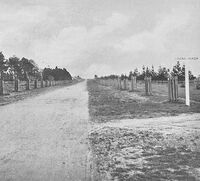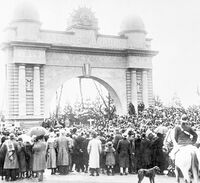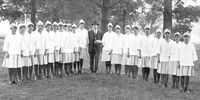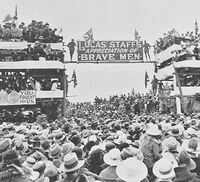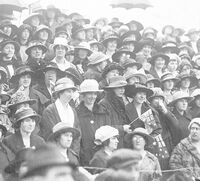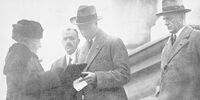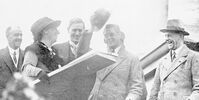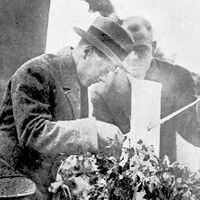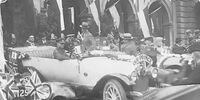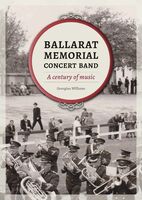Arch of Victory Ballarat
The world was still reeling from the effect of the global Spanish flu pandemic when His Royal Highness Prince Edward, the Prince of Wales, officially opened Ballarat's Arch of Victory on June 2nd, 1920. Now, exactly 100 years later, centenary celebrations are being limited by the COVID-19 pandemic.
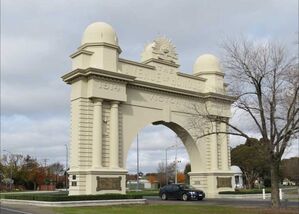
The Arch of Victory, one of Ballarat's most iconic structures, stands at the entrance to Australia's longest commemorative avenue of honour. Across Australia, the Arch is recognised as a symbol of Ballarat, but it has attracted international recognition and status. An exhibition in the world's most famous arch - the Arc de Triomphe in Paris - features a display of significant arches across the world. It features just one in Australia - Ballarat's Arch of Victory.
The Arch commemorates the Allied victory in the Great War but, for a community finally emerging from four years of anxiety and grief, the word "Victory" offered some consolation and comfort that the hardship had not been in vain.
The Lucas Girls:
The Arch of Victory was funded by female employees of Eleanor Lucas`s lingerie factory and opened by Prince of Wales to commemorate those who served in World War One. It forms the entrance to the Avenue of Honour. The Arch of Victory remains intact but memorial plaques were added in 1954 and 1987 to commemorate those who served in World War Two and in the conflicts in Korea, Borneo, Malaya and Vietnam.
In May 1917, Mrs W. D. Thompson, a director of clothing firm E. Lucas & Co, suggested planning an Avenue of Honour at Ballarat. The idea was accepted enthusiastically with planting beginning on 3 June 1917. The final planting took place on 3 June 1919. This avenue extends for a distance of 14 miles and contains 3,900 trees which were individually planted by "The Lucas Girls" for every Ballarat citizen who served in the Great War and assisted in maintaining the liberty of Australia.
Eleven species, totalling 3,912 trees, had been planted in eight phases by the staff of the Lucas factory with the support of local farmers, who provided tree guards. Each of the plantings was accompanied by Members of Parliament and in some cases by the Premier of the State. The cost of the trees was £2,000, raised by girls at the factory, which employed over 500 women. Hard physical work was also no trouble for the Lucas Girls with direct involvement in planting many of the trees in the middle of winter over 3 years and eight planting days (1917 to 1919), and even to the extent of loading bricks from the factory themselves onto carts for the construction of the Arch of Victory. Fundraising activities undertaken by the Lucas Girls included clothing exhibitions, sale of souvenirs and a lady’s football match in 1918 (£320 raised). A further £2,600 was raised to build the Arch of Victory as an entrance to the Avenue of Honour.
The Lucas association persisted with £2,000 raised in 1925 for the installation of new bronze name plaques and in fact still continues today by the ‘Lucas Past Employees Association’ e.g. $15,000 in 1993 for the ‘Memorial Wall’ and annual donations to the Arch of Victory/Avenue of Honour Committee e.g. $1500 in 2014.
While the original winner of the design competition was H. H. Smith of Ballart, the Lucas Girls who funded the Arch overturned that decision and chose a design by young Melbourne architecture students - Deane B. White, a pupil of architect Fred S. Mackay and R. Ellis, a pupil of architect P. C. Kirk.
The Arch of Victory and Avenue of Honour were rededicated on the 6th November 2011.
Plaque:
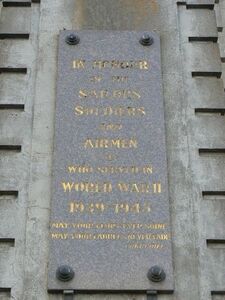
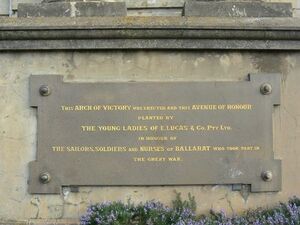
Front Inscription
The Avenue of Honour
1914 Victory 1919
Left Side Inscription
This Arch of Victory was erected and this Avenue of Honour Planted by the Young Ladies of E. Lucas & Co. Pty Ltd.
“In honour of the sailors, soldiers and nurses of Ballarat who took part in the Great War.”
This stone was laid by H.R.H. The Prince of Wales to commemorate the opening of this Arch.
Right Side Inscription
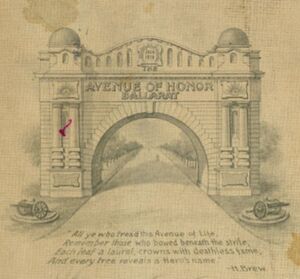 This avenue extends for a distance of 14 miles and contains 3,900 trees which were individually planted by "The Lucas Girls" for every Ballarat citizen who served in the Great War and assisted in maintaining the liberty of Australia.
This avenue extends for a distance of 14 miles and contains 3,900 trees which were individually planted by "The Lucas Girls" for every Ballarat citizen who served in the Great War and assisted in maintaining the liberty of Australia.
"All ye who tread this avenue of life,
Remember those who bowed beneath the strife,
Each leaf a laurel, crowns with deathless fame
and every tree reveals a hero s name.”
This stone was laid by Gen. Sir Wm. R. Birdwood, Bart. G.C. M.G. K.C.B., K.C.S.I, G.I.E.,D.S.O.G.O.C. Australia's soldiers in the Big War 1914 - 1919.
Reign of King George V.
Arch of Victory, c1920, Courtesy University of Ballarat Historical Collection [Cat.No.1279].
Construction:
The foundation stone for the Arch was laid by General Sir William Birdwood on February 7th, 1920. A team of thirteen local bricklayers, plasterers and carpenters undertook the construction which was completed in four months and utilised 70,000 bricks donated by the local Selkirk company.
The Arch stands at 17.5 metres high and 19.7 metres wide, and is topped by the emblem of the AIF - the Rising Sun.
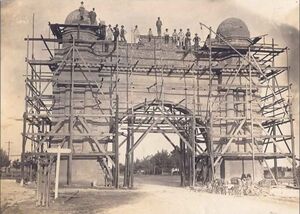
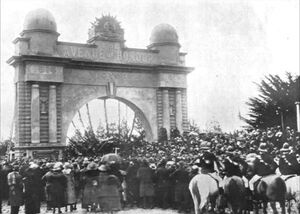
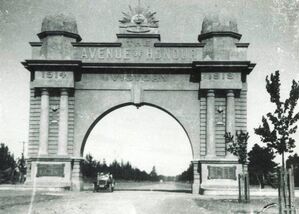
On Sunday 13th March 1938, Mr S. Walker, President of the Ballarat RSSIA unveiled the Temple of Remembrance which is situated at the entrance of the Avenue of Honour.
The temple houses a Book of Remembrance which contains a number of steel sheets upon which have been inscribed the names of every person in whose honour a tree has been planted in the Avenue.
On the 7th of November 1954, Lieutenant General Sir Leslie Morshead unveiled two tablets to acknowledge the services of the men and women from Ballarat in the 1939 - 1945 war.
Acknowledgement and thanks to:
Monuments Australia
City of Ballarat
Avenue of Honour: Honouring our ANZACS
Arch of Victory Centenary

